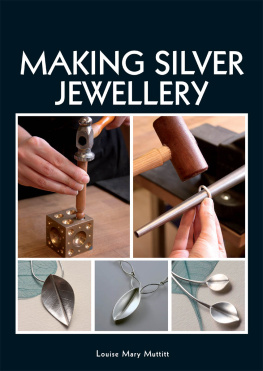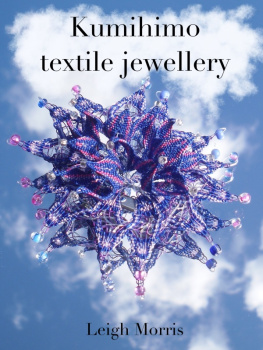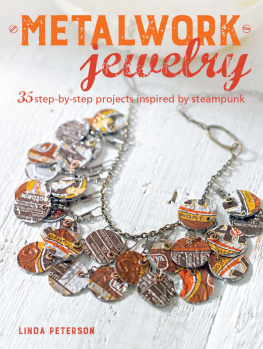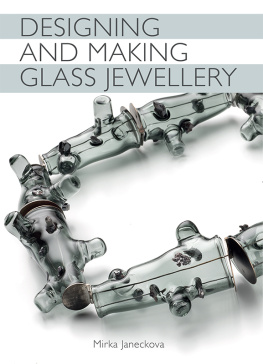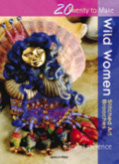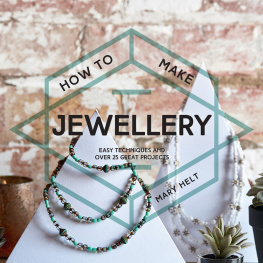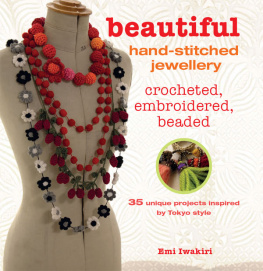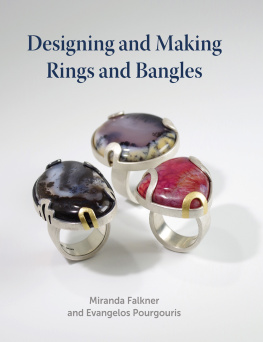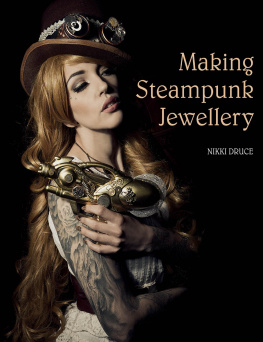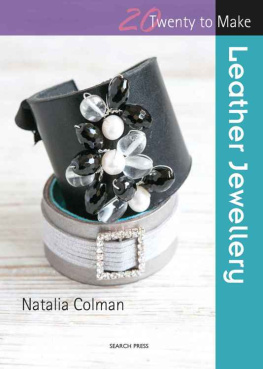Acknowledgements
I would like to dedicate this book to my wonderful family, who are my husband Martin and my Mum, both of whom give me endless support and help in everything that I do, as well as my brothers and sisters, Anthony, Matthew, Katie and Rosie. You are all pillars of strength to me and I would never have achieved all I have without you. I would also like to extend my thanks to my friends for their continued support. Particular thanks go to Hannah Bates for photography and Natalia Sarrazin for assistance in making jewellery samples. I would also like to thank every individual who has taught me various elements of the craft of silversmithing over the years, and the people who have bought and commissioned works, which enable me to continue to practise the work that I love every day.
MAKING SILVER JEWELLERY
Louise Mary Muttitt

First published in 2014 by
The Crowood Press Ltd
Ramsbury, Marlborough
Wiltshire SN8 2HR
www.crowood.com
This e-book first published in 2014
Louise Mary Muttitt 2014
All rights reserved. No part of this publication may be reproduced or transmitted in any form or by any means, electronic or mechanical, including photocopy, recording, or any information storage and retrieval system, without permission in writing from the publishers.
British Library Cataloguing-in-Publication Data
A catalogue record for this book is available from the British Library.
ISBN 978 1 84797 684 0
CONTENTS
INTRODUCTION
This book aims to be an accessible introduction to the wonderful possibilities of making jewellery in silver. It moves through an extensive range of techniques from simple cutting and filing through to more advanced skills such as fold forming and keum-boo. These are all made accessible with step-by-step guides to the processes, which you can then put into practice in your own pieces. Many of the techniques can be achieved in a small space without the need for significant investment in tools and equipment, and by following these guides you will be able to create high-quality jewellery items in silver.
Making silver jewellery can at times be very challenging; sometimes the solder just will not run as you would like it to, or you heat a piece too much and it melts. Rest assured, it has happened to us all at some point, and your skills will improve with practice. One of the pleasures of making jewellery by hand is the knowledge of the hard work that has gone into the making of a piece. Take pride in the pieces that you make and take time to make and finish them with care. Ensure that solder seams are tight fitting before attempting to solder, smooth edges of pieces properly, remove firestain and make sure that the final surface finish is beautiful. This attention to detail will be evident in the pieces that you make.
It has always given me great joy to make things. Growing up in rural north Herefordshire, my Mum always had projects on the go, from tapestry to knitting, and so as a child I followed in her footsteps, having my own sewing basket with projects inside. Towards the end of primary school I recall starting to collect tiny beads and threading them into necklaces, little knowing then it would be the starting point for my career. Looking back, I can see that working on a small scale has always come naturally to me. About four years later, I attended an after-school club making silver jewellery. For me, the joy of working in silver was instant, and it was not long before I was making my first silver jewellery collection in the garage. In writing this book I have enjoyed remembering that first time I was introduced to silver. It still brings me a moment of delight when a piece is finally completed, turning it and seeing how the surface finish plays with the light around it as the magical quality of the silver shines through.
Growing up in a rural area meant I was surrounded by wonderful plants and flowers all the time, and this led me to greatly appreciate nature. It seems that my instinctive tendency to design and make pieces on a small scale also translates to the inspiration that I source as an artist. Whether I am looking at an oak tree or a more exotic flower in a botanical garden, I am drawn to the immense detail of a single leaf rather than an entire plant. I still marvel as I discover yet more creations by nature in the plant world, and always have a camera close at hand to capture an interesting form. These sources of inspiration are the basis for the development of my jewellery and silverware designs. I have devoted a chapter to helping you to find your own inspirations and resources for jewellery designs, and have also given practical advice for the more technical considerations when designing jewellery.
I studied for a degree in Metalwork and Jewellery at Sheffield Hallam University and as part of the course I spent a semester at Kookmin University in Seoul, South Korea, which was where I learned how to use keum-boo. My workshop is now located in Birminghams historic Jewellery Quarter where my practice benefits from a range of highly skilled craftspeople in the local community, from gold platers to stone setters. I continue to thrive on natural sources, such as plants, as inspiration for my designs and take great care over the detail of pieces. For almost a decade now I have been making jewellery and silverware to sell, via galleries and at exhibitions, as well as making pieces to commission for private clients.

Finishing a silver bracelet using wire wool.
This book describes many of the techniques and methods that I use in my own practice as a silversmith. I have had the privilege of being taught by many highly skilled craftspeople over the years. We all do things slightly differently, so take these techniques as a starting point, as you may find effective ways of altering them to suit you. Once you have tried some of the step-by-step techniques and projects, you will hopefully feel more confident about branching out with your own designs. One of the biggest lessons I have learned and would like to pass on to you when working on a new design is this: always think several steps ahead. Time spent planning the processes in order may well save a lot of time later on. For example, when planning to bend a piece of metal, should it be protected with some tape so that it does not get marks which would need to be filed out afterwards? When unsure about a new process or design, trying a sample in brass or copper first can be an effective way to iron out practical issues. Keep a written and photographic record of pieces you make, whether finished or experimental, so that when you want to make a piece again or do something similar you will have notes to refer to which will tell you important technical details such as exactly which diameter the wire was or what you set the rolling mill thickness to.
To be able to spend time making objects and jewellery in silver is a joy, but to have practised these skills for long enough and to have reached a level to be able to share them with others is a great pleasure indeed. As my own enriching creative journey as a silversmith continues, I hope that this book will inspire you and help lead you towards discovering the joy of making jewellery in silver.

